If there’s one fruit-bearing vine you won’t regret planting in your own backyard, it would have to be passion fruit.
Their deep purple or yellow fist-sized fruits can make any garden picturesque — and that’s just the tip of the iceberg.
Once ripened, a passion fruit will give you plenty of juice to use on cocktails and in syrups. You can really stretch out the benefits of growing passion fruit in your garden.
My favourite way to enjoy a passion fruit? Nicely thickened with a bit of sugar and lemon juice, then swirled over a slice of pavlova. Try it sometime!
Popular passion fruit varieties
While you can find more than 50 passion fruit varieties, the most common types have a deep purple or yellow colour.
In Australia, you’ll likely see the Nellie Kelly variety grown in most gardens. This sturdy variety can hold its own even in regions with low temperatures.
They’re also pest- and disease-resistant, which makes them easy to maintain.
The Panama passion fruit is another popular variety. The pulp of this red or yellow passion fruit is sweet and produces plenty of juice.
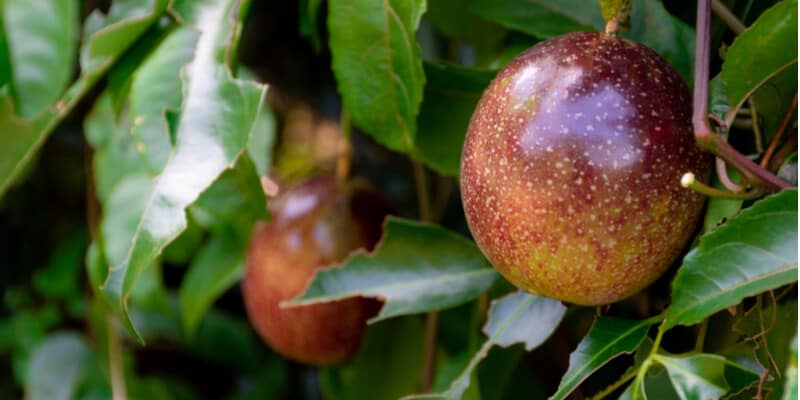
How to grow passion fruit from cuttings
Growing passion fruit from cuttings is a breeze.
You just need a sharp pair of gardening shears, growth hormone, and a small jar filled with water.
- Cut off a thick cutting from the main vine.
- Clear the cutting of pests, new flower buds, or young tendrils that can use up your plant’s energy and impede its growth.
- Cut off the leaves at the bottom of the cutting.
- Trim the tips of the leaf at the top of the cutting.
- Dip the bottom tip of the cutting in growth hormone.
- Put the cutting in a small vase or jar filled with water. Place it near a sunlit window to grow the roots out.
- When the roots start to appear, transfer your cuttings into small pots.
How to grow passion fruit in pots
No space? No problem. You can definitely grow your plant in pots. All you’ll need is a fence or trellis for your passion fruit that your vine can use as support (otherwise you risk having them topple to the ground!).
The size of your pot also matters. A container that’s 50 cm wide is big enough to hold your plant.
Simply fill with a good quality potting mix and position in an area of your garden where there’s full sun.
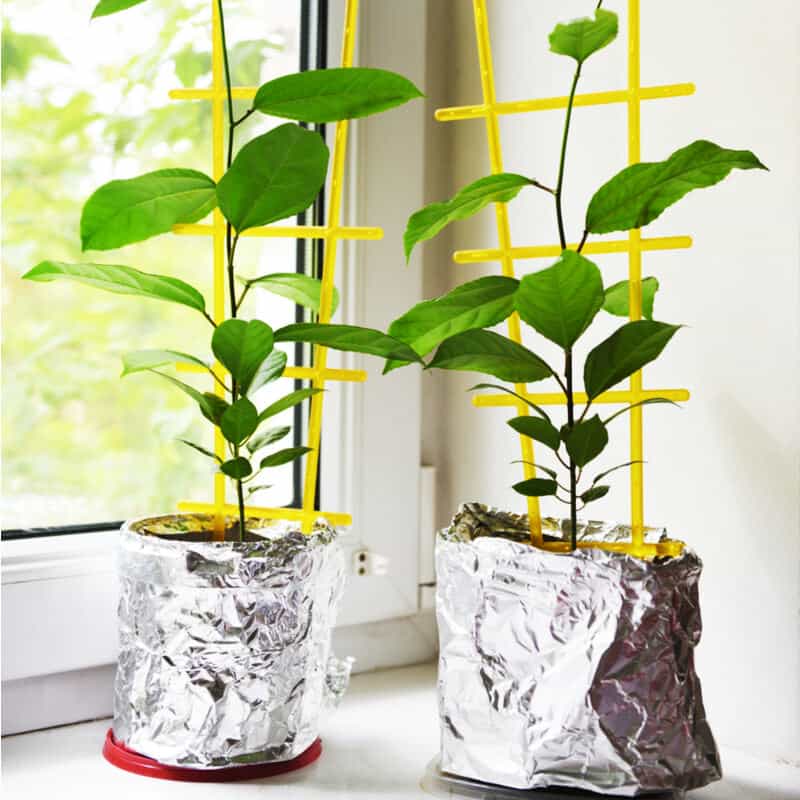
How to grow passion fruit from seed
Say you don’t have an existing vine to get a cutting from, but still want to have fresh passion fruit to add to your breakfast yoghurt (a few months into the future). No sweat.
Growing passion fruit from seeds in your own backyard is easier than you think. All you’ll need is full sun, sandy loam soil, a structural support, and a bit of space.
Dry out a passion fruit in your kitchen area until it becomes stale and dehydrated. When the fruit becomes brown and crinkly, crush the fruit to take the seeds out. Sprinkle the passion fruit seeds in a pot filled with seed-raising soil, then cover with potting mix. Water sufficiently.
It normally takes 18-24 months for a passion fruit vine to grow from seed and start bearing fruit, but in warmer regions, your passion fruit may bear fruit in just six months.
Growing passion fruit
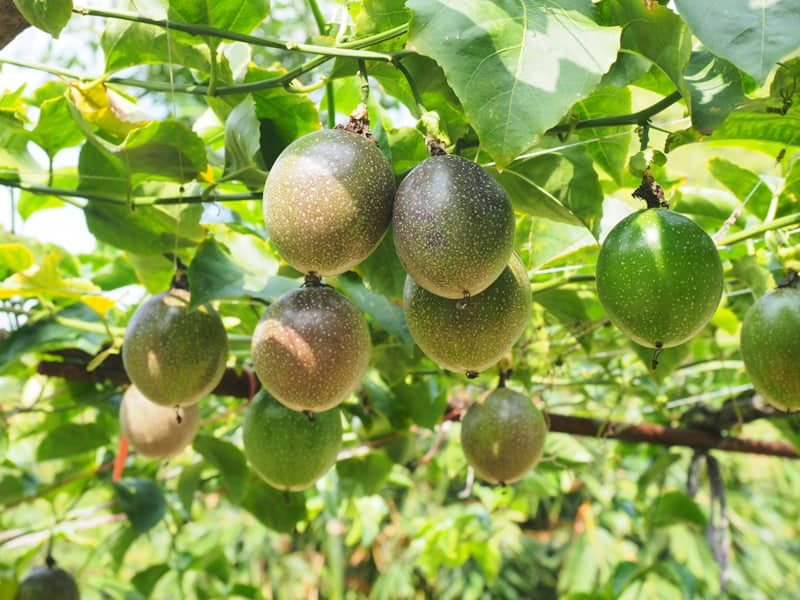
Now that you have passion fruit vines in your garden, keep them strong and healthy with these pro tips straight from our fruit-loving gardening experts.
In a few months’ time, you just might find yourself preparing a passion fruit mojito with fruit harvested from your own backyard.
Planting
Your passion fruit vine needs to grow in well-draining soil that’s rich organic matter.
Plant your passion fruit in sandy loam that has been enriched with compost or sheep pellets for a plant with robust leaves and branches.
Watering

Passion fruits are thirsty plants that need regular watering. You’ll need to do this more diligently when your vine is still young, and when it’s flowering or fruiting season.
Water your passion fruit a couple of times during the week.
If you notice that the weather is warmer, you may need to do this more frequently to prevent your plant from dehydrating.
Water evenly over the whole root system to ensure that your vine drinks up as much hydration as it can.
Fertilising
When fertilising your passion fruit, refrain from using fertilisers that are nitrogen-rich.
These fertilisers encourage foliage growth (which is a good thing for some plants!) and may interfere with your vine’s flower and fruit development.
Use chicken manure or well-watered-in citrus food instead, and fertilise twice a year during spring and autumn. Distribute the fertiliser over the entire root system to ensure maximum absorption.
Pruning
Pruning a passion fruit plant is a no-brainer. Unlike other vines that need constant maintenance and pruning, your fruit-bearing vine just needs a prune here and there to manage its growth and shape.
We’re talking about thinning out wayward tendrils or obstructive stems. Otherwise, there’s no need to pick up those shears and give your plant a trimming.
Prune ⅓ of the excess growth off during spring when new sprouts are emerging.
Only remove what’s necessary, and avoid cutting the vine’s main branches to prevent damaging your passion fruit permanently.
Harvesting
When to pick passion fruit
Your passion fruit vine will start bearing fruit 6 months into its growth, but if you give it more time to develop, you’ll be picking the best fruits when the vine is 18 months old.
There’s no need to wrestle with your passion fruit when it’s time to harvest, either – vine-ripened fruits will just fall from the plant without effort.
Or, if you want to go the extra mile and experience picking directly from the vine, you can certainly do so as soon as the fruits have ripened.
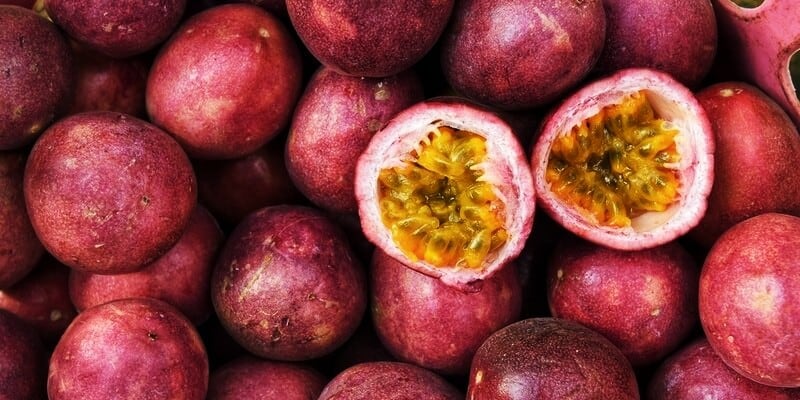
How to know if a passion fruit is ripe
Just like any fleshy fruits, passion fruits give telltale signs when they’re ripe enough to eat. Look for plump, cushy fruits whose colour is fully developed.
Depending on the variety, it can either be violet, dark yellow, orange or red.
Passion fruits with slightly wrinkled skin are usually sweeter and have had enough time to ripen under the sun.
Common passion fruit vine problems
Not producing fruit
It’s no fun at all if your passion fruit vine isn’t bearing fruit. But before you swear off cultivating passion fruits for good, there’s a way to solve this problem, and it starts with identifying the cause.
When your passion fruit plant is not bearing fruit, the usual culprit is poor pollination. Bees are the primary pollinators of passion fruit vines.
When there are weather fluctuations, changes in environmental temperature, or nonstop downpour, bees may pollinate less than usual, which thus affects the quantity of your crop.
Another possible reason why your plant is producing flowers but not fruit is over-fertilising.
You may want to cut back on the amount of fertiliser that you’re feeding your vine, and stick to the recommended twice-a-year fertilising schedule.
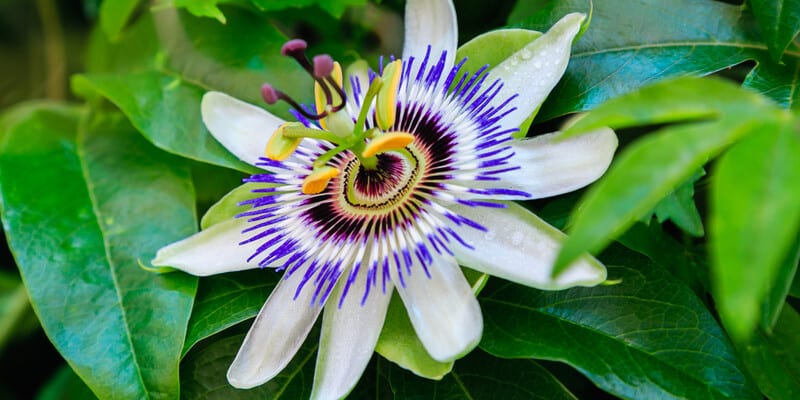
Dropping fruit
Here’s another dilemma: your plant is bearing fruit, but it keeps on dropping from the branch prematurely. That’s not good news, either.
Check your plant for fungal disease or fruit flies. If you have confirmed the presence of fungi, remove infected leaves and fruit and treat your plant with a fungicide.
Fruit fly infestation can be prevented with an organic insecticide.
If your plant does not have any of these problems, you may want to monitor the watering schedule and the amount of water you use. Irregular watering is one of the usual causes of dropping passion fruit.
Yellowing leaves

Passion fruit vines are known for their bright green foliage, but there is such a thing as yellowing passion fruit leaves.
There are three possible reasons why: a deficiency in magnesium or nitrogen, presence of woodiness virus, and cold temperatures or harsh winds that produce the so-called ‘winter yellows’.
Spots on leaves and fruits
Polka dots may look nice on other surfaces, but are a bane on your plants.
Treat brown spots in your passion fruit with a copper-based fungicide and remove any infected leaves and fruits to prevent the fungi from spreading further.
Extra care for your passion fruit
You’ve seen that growing passion fruit won’t require tremendous effort from your end.
The challenge is ensuring that you get to the part where you can enjoy your plant’s sweet, juicy fruits. That’s why you planted them, after all!
There are times when you’ve done everything you can to ensure that your plant bears fruit, to no avail.
While stubbornness isn’t exactly one of the qualities of your plant, this may be the right time to ask for some gardening help from local fruit tree experts.
When your passion fruit and other fruit-bearing trees receive professional plant care and maintenance, you can be sure that problems such as plant sickness and inability to bear fruit are treated swiftly and effectively.
No more worrying for you, only plump juicy fruits you can enjoy for years to come.

